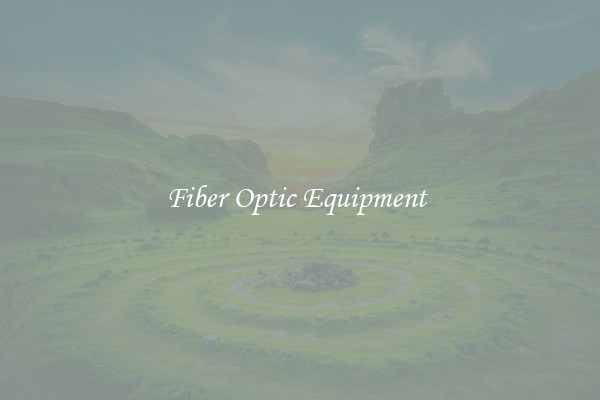Fiber Optic Equipment
Fiber Optic Equipment: Revolutionizing Communication

In today's fast-paced digital world, communication plays a vital role in connecting people from different parts of the globe. The development of fiber optic technology has significantly transformed the way people communicate and transmit data. Fiber optic equipment has become the backbone of our modern communication infrastructure, offering high-speed and reliable connectivity.
Fiber optic equipment refers to the various components and devices used in transmitting data through fiber optic cables. These cables are made of thin strands of glass or plastic, which transmit information in the form of light signals. Unlike traditional copper cables, fiber optic cables transmit data at the speed of light, allowing for faster and more efficient communication.
One of the key components of fiber optic equipment is the optical transmitter. This device converts electrical signals into optical signals, which are then transmitted through the fiber optic cable. Optical receivers, on the other hand, convert the incoming optical signals back into electrical signals for the recipient to process. These transmitters and receivers ensure that data is transmitted accurately and reliably.
Another important component of fiber optic equipment is the optical amplifier. Optical amplifiers are used to boost the strength of optical signals, allowing for longer transmission distances without loss of signal quality. These amplifiers are crucial for maintaining the integrity of data over long-haul communication networks.
Fiber optic equipment also includes various types of connectors and couplers. These connectors are used to join fiber optic cables together, enabling seamless communication between different devices and networks. Couplers, on the other hand, split or distribute optical signals to multiple destinations, allowing for efficient data distribution.
The use of fiber optic equipment has revolutionized several industries, especially telecommunications and internet services. Fiber optic cables provide much higher bandwidth capacity compared to traditional copper cables, enabling faster internet speeds and improved voice and video quality for users. This technology has led to the rapid development of high-speed internet services such as fiber-to-the-home (FTTH), which offers ultra-fast and reliable connectivity directly to households.
Furthermore, fiber optic equipment has also become essential in various sectors such as healthcare, finance, transportation, and defense. In healthcare, fiber-optic-enabled medical devices and equipment allow for real-time transmission of patient data, enabling remote monitoring and diagnosis. In finance, fiber optic networks ensure secure and fast transmission of financial data, protecting against potential cybersecurity threats. In the transportation sector, fiber optic systems enable real-time monitoring and control of traffic flow, improving safety and efficiency.
In conclusion, fiber optic equipment has revolutionized the way we communicate and transmit data. Its high-speed, reliability, and efficiency have made it the go-to choice for modern communication infrastructure. As technological advancements continue to unfold, fiber optic equipment will play an increasingly crucial role in shaping our digital future.

View details

View details

View details

View details








